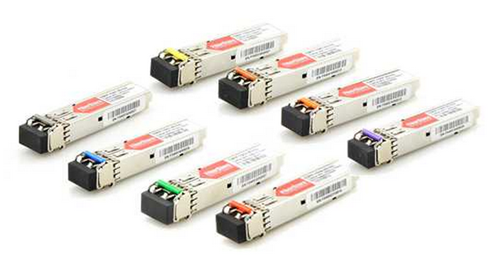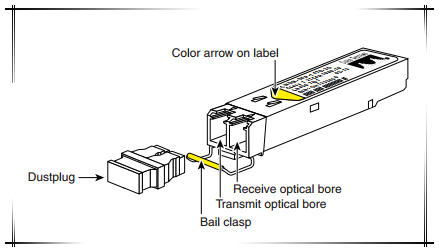SFP (Small Form-Factor Pluggable) is designed to meet Multi-Source Agreement (MSA) standards to ensure network equipment compatibility. Recently wavelength-division multiplexing (WDM) technology is warmly welcomed by internet users all around the world. It is a technology that multiplexes a number of optical carrier signals at different wavelengths of laser light over a single optical fiber. By using WDM technology, SFP module can have different wavelengths assigned to them. The following passage will be focused on the brief descriptions of CWDM SFP and DWDM SFP.
Overview of CWDM SFP
CWDM SFP is a kind of optical transceiver that utilizes in CWDM technology. Similarly with traditional SFP module, CWDM SFP is a hot-swappable input/output device that plugs into a SFP port or slot of a switch or router, linking the port with the fiber-optic network. CWDM SFP transceiver modules make use of the SFP interface for connecting the equipment and use dual LC/PC fiber connector interface for connecting the optical network. Colorful CWDM SFP modules are displayed below.
CWDM SFP is a kind of optical transceiver that utilizes in CWDM technology. Similarly with traditional SFP module, CWDM SFP is a hot-swappable input/output device that plugs into a SFP port or slot of a switch or router, linking the port with the fiber-optic network. CWDM SFP transceiver modules make use of the SFP interface for connecting the equipment and use dual LC/PC fiber connector interface for connecting the optical network. Colorful CWDM SFP modules are displayed below.

It is well known that CWDM SFP modules come in 8 wavelengths covering from 1470 nm to 1610 nm. Color markings on the devices identify the wavelength to which the Gigabit Ethernet channel is mapped. The following picture lists the CWDM SFPs with their wavelengths and color codes.

DWDM SFP Overview
DWDM (Dense Wavelength-Division Multiplexing) SFP transceivers are used as part of a DWDM optical network to provide high-capacity bandwidth across an optical fiber network, which is a high performance, cost effective module for serial optical data communication applications up to 4.25Gb/s. There are 32 fixed-wavelength DWDM SFPs that support the International Telecommunications Union (ITU) 100-GHz wavelength grid. The DWDM SFP transceivers have a duplex SC connector. An inner structure of DWDM SFP is shown below.
DWDM (Dense Wavelength-Division Multiplexing) SFP transceivers are used as part of a DWDM optical network to provide high-capacity bandwidth across an optical fiber network, which is a high performance, cost effective module for serial optical data communication applications up to 4.25Gb/s. There are 32 fixed-wavelength DWDM SFPs that support the International Telecommunications Union (ITU) 100-GHz wavelength grid. The DWDM SFP transceivers have a duplex SC connector. An inner structure of DWDM SFP is shown below.

Application
CWDM SFP transceiver is widely used in optical communications for both telecommunication and data communication. It is designed for operations in Metro Access Rings and Point-to-Point networks using Synchronous Optical Network (SONET), SDH (Synchronous Digital Hierarchy), Gigabit Ethernet and Fiber Channel networking equipment. The DWDM SFP can be also used in DWDM SONET/SDH (with or without FEC), but for longer transmission distance like 200km links and Ethernet/Fiber Channel protocol traffic for 80km links.
CWDM SFP transceiver is widely used in optical communications for both telecommunication and data communication. It is designed for operations in Metro Access Rings and Point-to-Point networks using Synchronous Optical Network (SONET), SDH (Synchronous Digital Hierarchy), Gigabit Ethernet and Fiber Channel networking equipment. The DWDM SFP can be also used in DWDM SONET/SDH (with or without FEC), but for longer transmission distance like 200km links and Ethernet/Fiber Channel protocol traffic for 80km links.
Which One Should You Choose, CWDM SFP or DWDM SFP?
From a low cost point of view, CWDM SFP module is inexpensive than DWDM SFP. It provides a convenient and cost effective solution for the adoption of Gigabit Ethernet and Fibre Channel. On the other hand, the key in selecting CWDM or DWDM SFP lies in the difference between CWDM and DWDM. They refer to different methods of splitting up the light. For example, CWDM uses broader spacing between channels, allowing for inexpensive SFPs, and DWDM uses denser channel spacing, which allows for more wavelengths to be used on a single fiber. DWDM is typically used in large optical networks over longer distance. Thus if you are looking for SFP modules over long distance and with better scalability, DWDM SFP module is the ideal choice.
From a low cost point of view, CWDM SFP module is inexpensive than DWDM SFP. It provides a convenient and cost effective solution for the adoption of Gigabit Ethernet and Fibre Channel. On the other hand, the key in selecting CWDM or DWDM SFP lies in the difference between CWDM and DWDM. They refer to different methods of splitting up the light. For example, CWDM uses broader spacing between channels, allowing for inexpensive SFPs, and DWDM uses denser channel spacing, which allows for more wavelengths to be used on a single fiber. DWDM is typically used in large optical networks over longer distance. Thus if you are looking for SFP modules over long distance and with better scalability, DWDM SFP module is the ideal choice.
I hope this brief introduction to CWDM/DWDM SFPs has been helpful for you to make a choice in selecting them. Fiberstore CWDM SFPs are based on the Cisco CWDM SFPs with multi-rate transceiver for data rates from 100 Mbps up to 4 Gbps, transfer distance at 20-40km, 40-80km and 80-120km with different colors marking the options that better satisfy the requirements of clients. All the DWDM SFP modules meet the requirements of the IEEE802.3 Gigabit Ethernet standard. They are suitable for interconnections in Gigabit Ethernet and Fibre Channel environments.
Originally published at www.fiber-optic-solutions.com
评论
发表评论